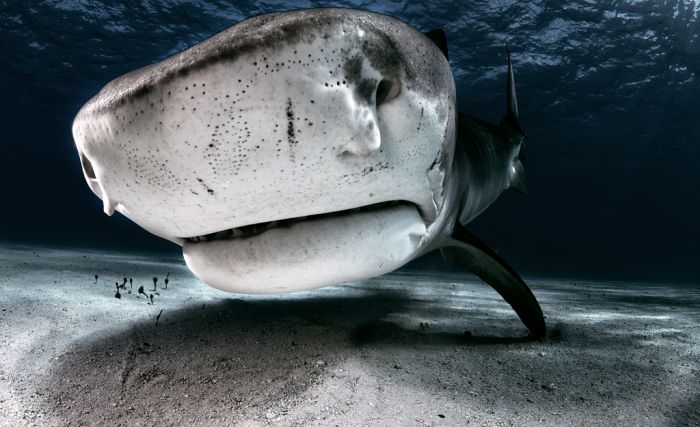|
|
Shark
|
Among the most ancient and primitive sharks is Cladoselache, from about 370 million years ago, which has been found within Paleozoic strata in Ohio, Kentucky and Tennessee. At that point in Earth's history these rocks made up the soft bottom sediments of a large, shallow ocean, which stretched across much of North America. Cladoselache was only about 1 metre (3.3 ft) long with stiff triangular fins and slender jaws. Its teeth had several pointed cusps, which wore down from use. From the small number of teeth found together, it is most likely that Cladoselache did not replace its teeth as regularly as modern sharks. Its caudal fins had a similar shape to the great white sharks and the pelagic shortfin and longfin makos. The presence of whole fish arranged tail-first in their stomachs suggest that they were fast swimmers with great agility.
Most fossil sharks from about 300 to 150 million years ago can be assigned to one of two groups. The Xenacanthida was almost exclusive to freshwater environments. By the time this group became extinct about 220 million years ago, they had spread worldwide. The other group, the hybodonts, appeared about 320 million years ago and lived mostly in the oceans, but also in freshwater.
Modern sharks began to appear about 100 million years ago. Fossil mackerel shark teeth date to the Lower Cretaceous. One of the most recently evolved families is the hammerhead shark (family Sphyrnidae), which emerged in the Eocene. The oldest white shark teeth date from 60 to 65 million years ago, around the time of the extinction of the dinosaurs. In early white shark evolution there are at least two lineages: one lineage is of white sharks with coarsely serrated teeth and it probably gave rise to the modern great white shark, and another lineage is of white sharks with finely serrated teeth. These sharks attained gigantic proportions and include the extinct megatoothed shark, C. megalodon. Like most extinct sharks, C. megalodon is also primarily known from its fossil teeth and vertebrae. This giant shark reached a total length (TL) of more than 16 metres (52 ft). C. megalodon may have approached a maxima of 20.3 metres (67 ft) in total length and 103 metric tons (114 short tons) in mass. Paleontological evidence suggests that this shark was an active predator of large cetaceans.
|
|









